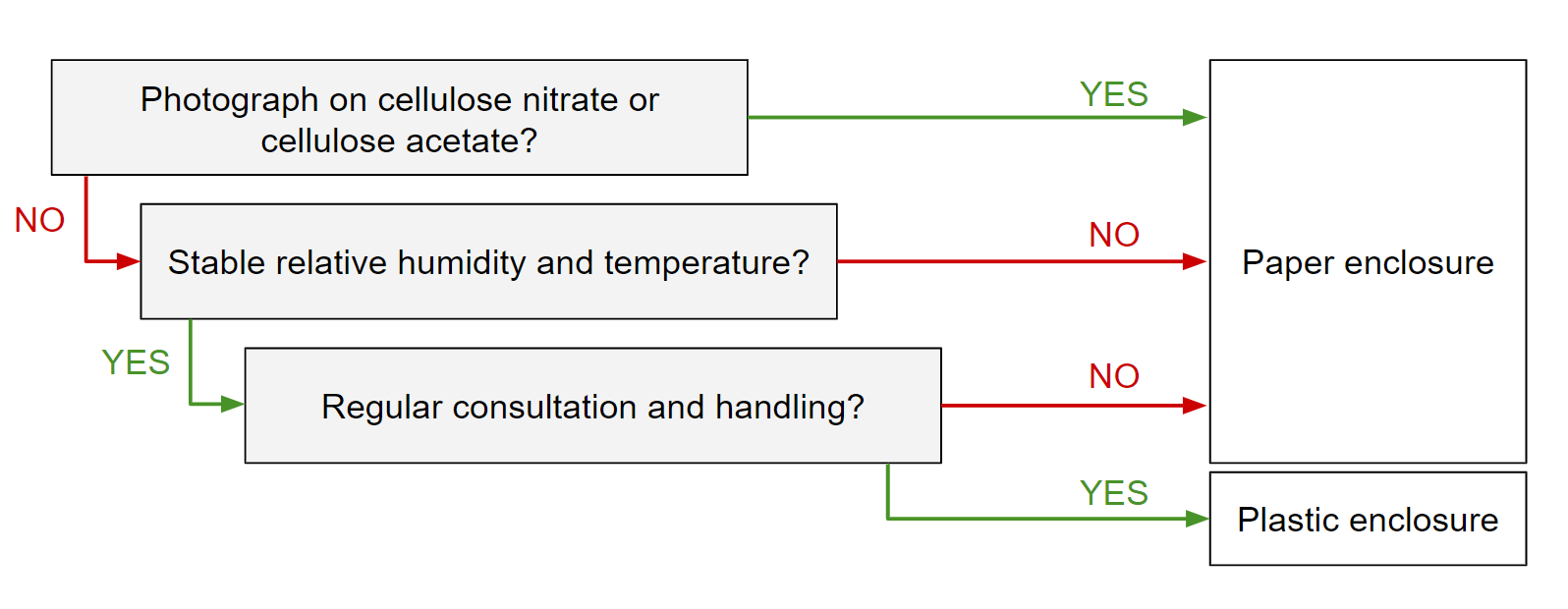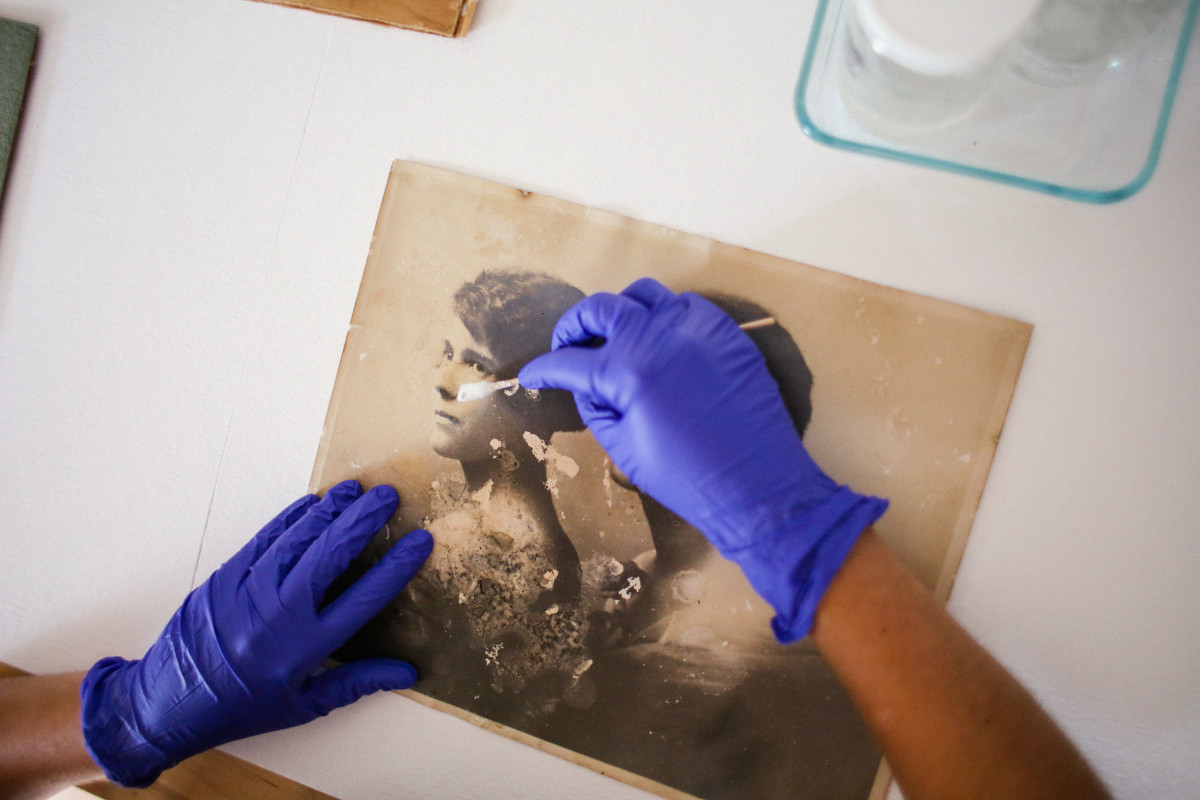Conservators around the world answer questions about their work on Ask a Conservator Day, the 2020 edition is held on November 18. On November 4, 2020 I asked my Facebook and Instagram followers to send me questions about photograph conservation. I received the following questions:
- Which storage solution is preferred for photographs: polyethylene sleeves or acid free paper folders/enveloppes?
- Is flat storage a must for photographs? Is it bad to store them on their side or upright, for example a folder kept in a box
- Contemporary photos: is it better framed or not? Glass or plexi?
- If I want to have my old photographs displayed, what are your recommendations?
- What solutions do you use to clean the image? Is it different for each photographic process? What are the criterias for choice?
- When the image has a silver mirror, what is the best thing to do?
The answers are gathered below.
I also answerred two questions through the Canadian Association of Professional Conservators, about freezing negatives and cold storage for post 1970 photographs.
Which storage solution is preferred for photographs: polyethylene sleeves or acid free paper folders/enveloppes?
Enclosures for photographs can be made out of paper or plastic (polyethylene, polyester or polypropylene). All materials in contact with photographic materials should pass the Photographic Activity Test (ISO 18916).
Both plastic and paper enclosures have their pros and cons:
Paper
+ Porous, breathable
+ Serves as a buffer for relative humidity variations
– More handling
Plastic
+ Less handling
– Non-porous (micro-climate)
– Electrostatic
Plastic enclosures can cause damage by trapping pollutants, off-gassing from the photographs (cellulose nitrate, cellulose acetate, acidic boards), inside the enclosure. They also create a microclimate which can lead to water condensation, when temperature varies, resulting in mould growth or gelatin emulsions sticking to the enclosure. Plastic can also cause damage to friable or flaking binder/support because of its electrostaticity.
In most cases paper enclosures are more appropriate as they do not trap pollutant and buffer relative humidity variations at the photograph’s level. In situations where the photographs are often consulted, plastic enclosures may be more appropriate than paper because repeated handling can be a source of damage (soiling, fingerprints, crease, tears, etc.).
The decision tree below can be helpful to determine the most appropriate enclosure material.

Is flat storage a must for photographs? Is it bad to store them on their side or upright, for example a folder kept in a box?
Photographs on paper are best stored flat in a box. Horizontal storage provides support to the whole surface of the print, in opposition to vertical storage that will put more weight and pressure on one edge of the print. The main risks with vertical storage are:
- warping of the prints,
- damage to the bottom edge (dents, abrasions, etc.),
- damage during handling in and out of the box (folds, creases, etc.).
Vertical storage can be chosen with the following precautions to lower the risk of damage:
- Prints should be 20 x 25 cm or smaller.
- Prints should be stored on their longer edge.
- Prints should be separated by sturdy dividers to prevent warpage. The dividers can be made of 8-ply matboard or corrugated board and placed every 10-20 cm, depending on the size of the box, the format and thickness of prints.
- The box should be snuggly filled to prevent print warpage. Spacers should be used to fill unused box space. They also simplify handling of the folders in and out of the box, lessening the risk of damage to the prints.
Vertical storage is more adapted to prints mounted on rigid secondary supports or prints on thick paper support. If necessary, additional matboards can be added within the individual folder to provide more support for prints on thin paper supports.

Contemporary photos: is it better framed or not? Glass or plexi?
Many contemporary photographers favour the aesthetic of face-mounted photographs, unframed photographs or framing without a protective glazing.
From a conservation perspective, the use of a frame with glazing has a lot of advantages. It provides protection against light, dust, pollutants, and mechanical damage such as abrasions or scratches.
Both glass and acrylic glazing have pros and cons which are to be taken into consideration before choosing which one will fit better for each object.
Glass
+ Clarity
+ Non-static
+ Durable
+ Stable
+ Affordable
– Inflexive and brittle
– Heavy
Acrylic
+ Light
– Can have colour cast and lack of clarity
– Electrostatic
– Can react to the off-gassing of uncured paints and printing inks by the formation of fogging or very fine crazing
– Large sheets flex and bow
– Large sheets can expand and contract in response to extreme temperature changes.
A lot of contemporary photographs are made in larger formats, thus the weight and inflexive qualities of glass can be a problem and acrylic glazing are often more suited to these objects. If the framed photograph is to travel, acrylic is also preferable because of the risk of glass breakage during transportation, which would damage the print.
If I want to have my old photographs displayed, what are your recommendations?
Photographs are very sensitive to light. Exposure to light can induce chemical damage to the constitutive materials such as fading, yellowing, or colour changes. The type of damage and sensitivity to light is specific to each photographic technique, and the condition of each object.
Unless the photograph is kept in the dark, the risk of light damage is never inexistant. In a private home context, there are several ways to provide protection to mitigate the risk of light damage while displaying the photograph.
- Keep away from direct natural light.
- Use the lowest light level possible.
- Use lights that do not contain infra-red or ultraviolet radiations.
- Display with a protective glazing containing UV filtering.
What solutions do you use to clean the image? Is it different for each photographic process? What are the criterias for choice?
Cleaning is always the first step of any conservation treatment, as it will remove loose or embedded soiling from the object.
I always start with dry cleaning techniques as they are less likely to damage the photograph and allow removal of any loose and slightly embedded dust/debris. Air bulbs, soft brushes, lense cleaning cloths and erasers can be used. It is important to be careful not to create abrasions on the surface, remove original inpainting or constitutive materials.
In some cases the dry cleaning does not remove all the embedded grime, particularly on the image binder, solvent cleaning can then be considered on a case by case basis.
As with all conservation treatments, there are risks associated with the treatments and the benefit/risk balance needs to be assessed prior to treatment. The solvent used to clean photographs does depend on the type of photographic process and constitutive materials. For example, some photographs have a collodion binder (collodion glass plate negatives, ambrotypes, tintypes, print out collodion prints) or varnish. Collodion is pyroxylin (cellulose nitrate) dissolved in ether and alcohol, and is soluble in alcohols, so if you try cleaning a collodion photograph with ethanol the image will simply be dissolved and disappear. Hence, before attempting any solvent cleaning treatment I need to be certain of the material and photographic technique involved.
The second thing to keep in mind is that every object is different, not all developing-out silver gelatin print will have the same reaction to one specific treatment, so to decide how to solvent clean a photograph the second step is to test each individual object to assess its reactivity to the treatment and determine if the treatment should be carried out and with what solvent solution.
For example for a photograph with a gelatin binder, water will be the most efficient at removing embedded grime, but will also make the gelatin swell the most and can dissolve it if the gelatin has previously been water or mould damaged and is partially/totally hydrolyzed. Sometimes no solvent cleaning is the best route to take.
Lastly I take into account the long term effect of the treatment on the materials: is the solvent going to react with the object and create damage? For example, albumen is sensitive to moisture/water and the binder likely to crack, modifying the gloss of the photograph.. Knowledge about the impact of conservation treatment on photographic materials keeps evolving with new research being undertaken by conservators worldwide, so the solution I use today may change tomorrow based on new research results. It is keeping me on my toes!

When the image has a silver mirror, what is the best thing to do?
Silver mirroring is a damage appearing as a bluish metallic sheen at the surface of silver-based photographs. The metallic silver forming the image is oxidized as Ag+ ions and migrates toward the surface of the photograph, where it is reduced to metallic silver with the contact of the air. Silver mirroring is caused by the presence of pollutants and catalyzed by humidity.
Because silver mirroring is made from silver originally forming the image, it is considered as original materials and as such should be preserved, according to the Code of Ethics: “ No aspect of a cultural [object] should be altered nor should material be removed from it without justification.” Silver mirroring can be considered as a patina, similar to the one found on objects made of metal.
The best thing to do is to prevent the silver mirroring from happening, by controlling the relative humidity and pollutants in the environment of the photograph.
In some cases the silver mirroring can be very extensive and prevent proper visualisation of the image. It can be particularly problematic on negatives where areas with silver mirroring appear darker with less contrast in transmitted light, which can then limit the original use of the object. In these cases, lessening of the silver mirroring can be considered. One thing to keep in mind is that it may not be possible to remove all the silver mirroring, it is not easy to remove it evenly, and because the silver that is removed used to be forming the image, the image underneath the silver mirroring may have lost density and contrast. The removal of silver mirroring may not be an aesthetically satisfying solution. The best solution is still to avoid silver mirroring in the first place.
Do you have another question about photograph conservation? Do not hesitate to contact me, I will be happy to help!



